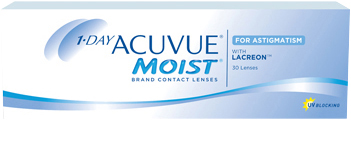You are currently not taking any of our courses.
Educate both your staff and your customers with our different courses!
1-DAY ACUVUE® MOIST integrates EYE-INSPIRED™ Innovations proprietary EyelidStabilised Design.1

Daily wear, 1-day replacement
| Lens material | etafilcon A |
| Technology | LACREON® Technology and EYELID STABILISED Design |
| Dk/t (boundary & edge corrected)4◊ | 23.8 x 10-9 |
| Oxygen % available to central cornea:6 | 88% |
| Water content | 58% |
| UV-blocker:* | Class 2 |
| Center thickness at-3.00D (mm) | 0.090 |
| Inside-out mark | No |
| Visibility tint | Yes |
| Package size | 30 lenses |
*All ACUVUE® Brand Contact Lenses have Class 1 or Class 2 UV-blocking to help provide protection against transmission of harmful UV radiation to the cornea and into the eye. UV-absorbing contact lenses are NOT substitutes for protective UV-absorbing eyewear such as UV-absorbing goggles or sunglasses because they do not completely cover the eye and surrounding area.
1. Sulley A, Young G, Lorenz K & Hunt C. Clinical evaluation of fitting toric soft contact lenses to current non-users. Ophthalmic Physiol Opt 2013, 33, 94–103.
2. Chamberlain P et al. Fluctuation In Visual Acuity During Soft Toric Contact Lens Wear. Optom Vis Sci 2011; 88: 534-538.
3. McIlraith R, Young G, Hunt C. Toric lens orientation and visual acuity in non-standard conditions. CLAE 2010; 33 (1): 23-26.
4. Osborn et al. Multi-Center Evaluation of A New Daily Disposable Toric Soft Contact Lens. AOA poster 2011.
5. Oxygen transmissibility at centre of a -3.00D lens using boundary-corrected, edge-corrected Dk values. Units: (cm/sec) (ml O2/ml x mm Hg) at 35° C. Dk determined via polarographic method.
6. Oxygen flux - % available to central cornea (open eye) and compared to 100% with no lens.
1-DAY ACUVUE® MOIST for ASTIGMATISM
EYELID STABILISED Design is based on a four-zone stability system that utilises positive eyelid interaction by harnessing the power of the eye blink
•Locked-in wetting agent PVP, creates along lasting cushion of moisture from the core to the surface of the lens.5,6
•Etafilcon A helps keep the tear filmenzyme, Lysozyme, in its natural state,which has been shown in vitro to help maintain low levels of inflammatory biomarkers released by the corneal epithelium that can lead to irritation.7#
EYELID STABILISED Design helps provide clear and stable vision so you can enjoy your regular activities1.
1-DAY ACUVUE® MOIST integrates EYE-INSPIRED™ Innovations1:
Packing solution contains boric acid and disodium tetraborate (sodium borate) to control the pH of the solution.
†14 clinical studies posted on ClinicalTrials.gov, a website maintained by the NIH, evaluated subjective comfort as a primary or secondary endpoint for 1-DAY ACUVUE® MOIST brand family (spherical, astigmatism, and multifocal) contact lenses. Published trials include comparisons between etafilcon A and nelfilcon A, omafilcon A, hilafilcon B, ocufilcon D and nesofilcon A. Review conducted as of April 29, 2022.
$Based on publicly available manufacturer information as of March 2020
◊Oxygen is only one of several factors relatedto maintaining overall eye health when wearing contact lenses.
#Based on in-vitro data, clinical studies have not been done directly linking differences in lysozyme profile with specific clinical benefits.
¶All ACUVUE® contact lenses have Class 1 or Class 2 UV-blocking to help provide protection against transmission of harmful UV radiation to the cornea and into the eye. UV-absorbing contact lenses are NOT substitutes for protective UV-absorbing eyewear such as UV-absorbing goggles or sunglasses because they do not completely cover the eye and surrounding area
1.JJV Data on File 2021. ACUVUE BrandContact Lenses for ASTIGMATISM -Overall Fitting Success, OrientationPosition, Rotational Stability, and VisionPerformance.
2.JJV Data on File 2020. 1-DAY ACUVUEMOIST Family Parameters Coverage
3.JJV Data on File 2021. ProportionAstigmats Accommodated withACUVUE® Brand Contact Lenses forASTIGMATISM.
4.JJV Data on File 2022. MaterialProperties: 1-DAY ACUVUE MOIST, 1-DAY ACUVUE TruEye, ACUVUEOASYS 1-Day with HydraLuxeTechnology and ACUVUE OASYS MAX1-Day with TearStable Technology BrandContact Lenses.
5.JJV Data on File 2018. Similaritiesbetween Mucin and Poly(N-VinylPyrrolidone) (PVP).
6.JJV Data on File 2018. Dual ActionTechnology and "Cushion of Moisture"Description for 1-DAY ACUVUE MOISTBrand Family of Contact Lenses
7.Heynen M, Omali NB, Fadli Z, et al.Selectivity and localization of lysozymeuptake in contemporary hydrogel contactlens materials. J Biomater. Sci. Polym. Ed.2017;28(13):1351-1364. doi:10.1080/09205063.2017.1327751